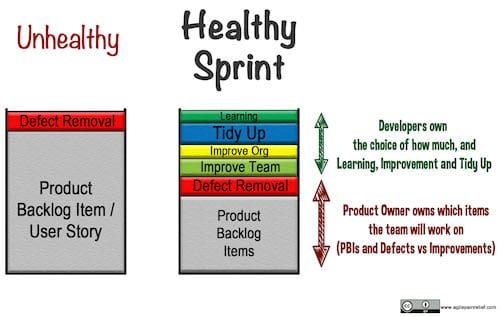Slack
Slack, in the context of Agile/Scrum, is when the time isn’t solely focused on delivering. (It’s important not to confuse this with Slack, a popular electronic communication tool, or the general vocabulary word defined as “a spell of inactivity or laziness”.)

Slack time can be used as a buffer to deal with unexpected problems, issues, etc (see: Production Support), and Slack time is also for learning. Problems ensue when the Slack time for learning is only used for urgent issues.
Show me the rate at which your team is Learning (and adapting), and I will predict where they will be in a year.
When there isn’t enough Slack in the system:
- Dependencies from other teams get dropped or missed
- There is no room to take care of small problems, so they accumulate and become large
- People burnout
- Technical Debt piles up, making the new feature work hard
In the Agile world, some approaches, like Scaled Agile, conflate both kinds of slack by lumping unexpected problems and learning time into the same bucket. This means Learning Time gets the short end of the stick.
Systems with no Slack are fragile and will break down when challenges appear. Healthy teams budget 15-20% of their time in every Sprint for Slack. With a Canadian audience, Slack is like the tax we pay to have a working healthcare system. To managers, I point out that while it looks more expensive up-front, it is more costly later when you have to pay the price of a fragile system.
Related Articles
- Speed Trap: How the Obsession with Speed is Building a Fragile Organization - A fragile organization that goes faster will be knocked over in the slightest wind.
- Cross-Skilling requires Learning Time
- Scrum by Example – How to Handle Production Support Issues in Scrum - One common approach to Production Support uses slack time.
Resource Links
- AoAD2 Practice: Slack
- Collaborative Learning (an index) and Collaborative Learning Structures and Techniques
- Cultivate Team Learning with Xtrem Reading
- Fundamentals of Transportation/Queueing
- Good Housekeeping
- Group work: Using cooperative learning groups effectively
- Grow a culture of innovation and learning with frequent Developer Huddles
- How to Spread Technical Practices Like TDD in an Organization
- Increase Learning with 10% Autonomy Time
- Increasing Learning in an Agile Environment: Lessons Learned in an Agile Team
- Long Term Learning of Agile Teams
- Slack, by Martin Fowler
- Slack Time
- What is Learning Agility and Why Organizations Need to Focus on It
- Why the second-busiest international airport is often so nightmarishly fragile
